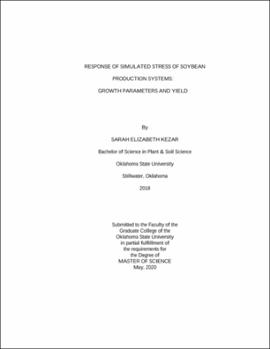| dc.contributor.advisor | Lofton, Josh | |
| dc.contributor.author | Kezar, Sarah Elizabeth | |
| dc.date.accessioned | 2020-09-09T20:58:55Z | |
| dc.date.available | 2020-09-09T20:58:55Z | |
| dc.date.issued | 2020-05 | |
| dc.identifier.uri | https://hdl.handle.net/11244/325475 | |
| dc.description.abstract | Soybean (Glycine max) hectares planted in western Oklahoma have recently increased by 75.9%, but soybean-growing challenges are unknown in the region, which has historically been dominated by small-grain production. To overcome latent yield limitations, it is critical to recognize soybean physiological response to stressors and potential for recovery. Thus, two studies were conducted to evaluate challenges associated with producing soybean in western Oklahoma, or dryland systems in low precipitation regions, and how to measure soybean response in those conditions. | |
| dc.description.abstract | The first study was designed to study the physiological changes from simulated stress during critical yield determination stages by removal of reproductive structures at R2, R3, and R5 on cumulative mainstem locations. Trials were conducted in 2018 and 2019 in Oklahoma. Field study results indicated significant yield recovery potential when stress was imposed at R2 and R3. Significant impact was observed on seed weight and seed number that occurred when stress was imposed at R5. Moreover, when significant pod removal is experienced at R5, soybean has potential to develop green-stem. This physiological reaction, due to a source to sink imbalance in favor of the source, retaining assimilates and leaving plants unharvestable as a reaction to intolerable stressors. | |
| dc.description.abstract | Furthermore, to determine the physiological response of moisture stress during high water requirement stages of R2, R3, and R5, a growth chamber study was conducted. The effect of moisture stress duration of 7 or 14 days was significant, with all plants experiencing 14 days of moisture stress reducing yield potential. In correlation with the field study, it was also found that soybean reproductive stages R3 and R5, especially, experienced yield impact. | |
| dc.description.abstract | It was concluded that impact of stress on yield is minimal at R2, increases at R3, and is greatest at R5. This can be attested to the fact that moisture stress influences seed growth to some extent at all stages, but specifically during R5 with the greatest yield impact by seed number reduction. Soybean reaching genetic potential in such dryland systems can only be achieved by physiological response to stressors and mitigation of yield losses. | |
| dc.format | application/pdf | |
| dc.format | application/vnd.ms-excel | |
| dc.language | en_US | |
| dc.rights | Copyright is held by the author who has granted the Oklahoma State University Library the non-exclusive right to share this material in its institutional repository. Contact Digital Library Services at lib-dls@okstate.edu or 405-744-9161 for the permission policy on the use, reproduction or distribution of this material. | |
| dc.title | Response of simulated stress of soybean production systems: Growth parameters and yield | |
| dc.contributor.committeeMember | Warren, Jason | |
| dc.contributor.committeeMember | Haggard, Beatrix | |
| osu.filename | Kezar_okstate_0664M_16679.pdf | |
| osu.accesstype | Open Access | |
| dc.type.genre | Thesis | |
| dc.type.genre | Numeric data | |
| dc.type.material | Text | |
| dc.type.material | Dataset | |
| dc.subject.keywords | dryland soybean production | |
| dc.subject.keywords | green-stem | |
| dc.subject.keywords | moisture stress | |
| dc.subject.keywords | physiological response | |
| dc.subject.keywords | simulated stress | |
| dc.subject.keywords | soybean | |
| thesis.degree.discipline | Plant and Soil Sciences | |
| thesis.degree.grantor | Oklahoma State University | |
